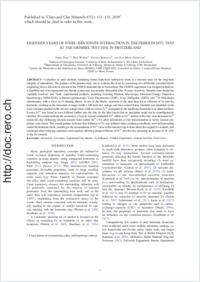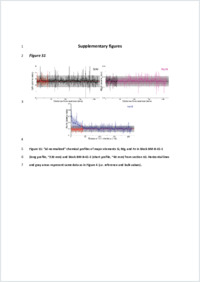Eighteen years of steel–bentonite interaction in the FEBEX in situ test at the Grimsel Test Site in Switzerland
- Hadi, Jebril Institute of Geological Sciences, University of Bern, Switzerland
- Wersin, Paul Institute of Geological Sciences, University of Bern, Switzerland
- Serneels, Vincent Département de Géoscience, Université de Fribourg, Switzerland
- Greneche, Jean-Marc Institut des Molécules et des Matériaux du Mans, Université du Maine, Le Mans, France
-
2019
Published in:
- Clays and Clay Minerals. - 2019, vol. 67, no. 2, p. 111–131
English
Corrosion of steel canisters containing buried high-level radioactive waste is a relevant issue for the long-term integrity of repositories. The purpose of the present study was to evaluate this issue by examining two differently corroded blocks originating from a full-scale in situ test of the FEBEX bentonite site in Switzerland. The FEBEX experiment was designed initially as a feasibility test of an engineered clay barrier system and was recently dismantled after 18 years of activity. Samples were studied by ‘spatially resolved’ and ‘bulk’ experimental methods, including Scanning Electron Microscopy, Elemental Energy Dispersive Spectroscopy (SEM-EDX), μ- Raman spectroscopy, X-ray Fluorescence (XRF), X-ray Diffraction (XRD), and 57Fe Mössbauer spectrometry, with a focus on Fe-bearing phases. In one of the blocks, corrosion of the steel liner led to diffusion of Fe into the bentonite, resulting in the formation of large (width > 140 mm) red, orange, and blue colored halos. Goethite was identified as the main corrosion product in the red and orange zones while no excess Fe2+ (compared to the unaffected bentonite) was observed there. Excess Fe2+ was found to have diffused further into the clay (in the blue zones) but its speciation could not be unambiguously clarified. The results indicate the occurrence of newly formed octahedral Fe2+ either as Fe2+ sorbed on the clay or as structural Fe2+ inside the clay (following electron transfer from sorbed Fe2+). No other indications of clay transformation or newly formed clay phases were found. The overall pattern indicates that diffusion of Fe was initiated when oxidizing conditions were still prevailing inside the bentonite block, resulting in the accumulation of Fe3+ close to the interface (up to three times the original Fe content), and continued when reducing conditions were reached, allowing deeper diffusion of Fe2+ into the clay (inducing an increase of 10– 12% of the Fe content).
- Faculty
- Faculté des sciences et de médecine
- Department
- Département de Géosciences
- Language
-
- English
- Classification
- Engineering materials
- License
- License undefined
- Identifiers
-
- RERO DOC 326973
- DOI 10.1007/s42860-019-00012-5
- Persistent URL
- https://folia.unifr.ch/unifr/documents/308115
Other files
Statistics
Document views: 118
File downloads:
- ser_eys.pdf: 134
- ser_eys_sm.pdf: 84

